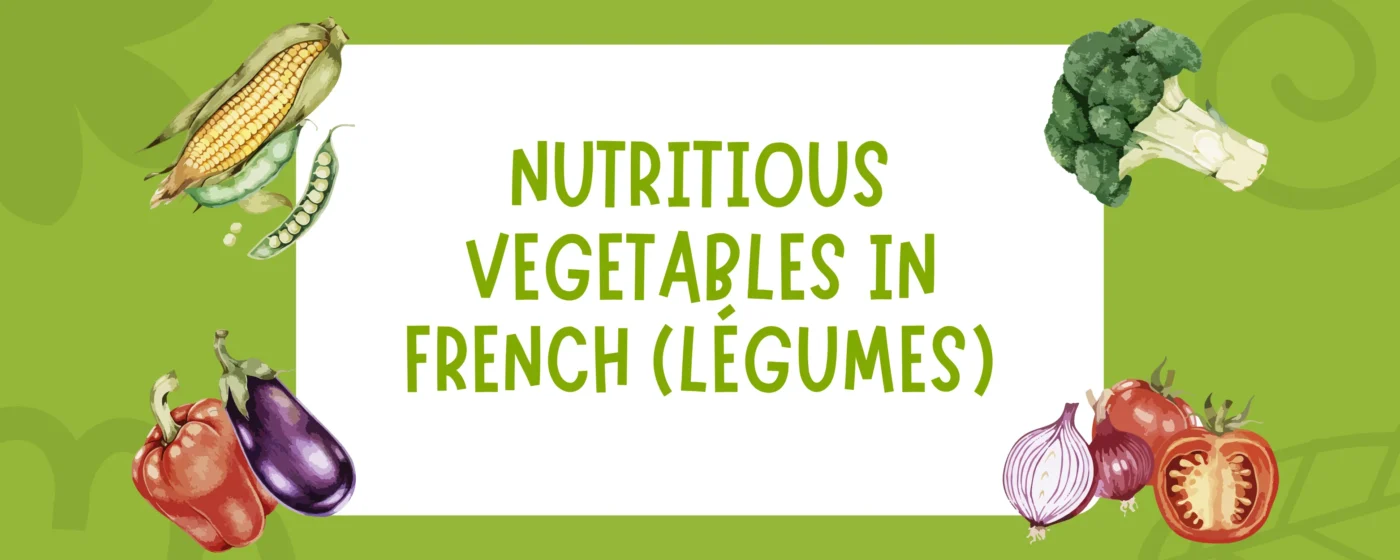French cuisine is renowned for its exquisite flavours and emphasis on seasonal, fresh ingredients, particularly vegetables, is a cultural treasure. Exploring the diverse range of vegetables used in French cooking not only deepens our understanding of this culinary art but also fosters a sense of connection with the rich cultural heritage it represents. This comprehensive guide will delve into the various types of vegetables used in French cooking, their unique characteristics, their popular uses, and their integral role in the country’s cuisine.
Vegetables in French
The Root Vegetables (Légumes Racines)
Plant roots, sometimes called “légumes racines” in French, play a key role in many classic French recipes. These robust veggies offer a range of tastes, from earthy to sweet, and thrive in cool climates. Prominent examples include:
Les carottes (Carrots): Their vivid orange color makes carrots a popular ingredient in stews, soups, and side dishes.
Les navets (Turnips): Turnips add a somewhat piquant flavor and richness to recipes such as purées and pot-au-feu.
Les betteraves (Beets): Beets bring their earthy sweetness to salads, soups, and even traditional French desserts like beetroot tart.
Les panais (Parsnips): Parsnips, or panais, offer a sweet and nutty flavor and are often mashed, roasted, or added to soups and stews as a side dish.
Le gingembre (Ginger): The ginger plant, Zingiber officinale, produces this spicy root. For thousands of years, people have used ginger in traditional medicine and food for its anti-inflammatory, digestive, and antioxidant properties.

Bulb Vegetables (Légumes Bulbes)
Vegetables with bulbous structures that grow underground are known as bulb vegetables, or “légumes bulbes” in French. These veggies contribute a fragrant depth to French cuisine and include:
Les oignons (Onions): Onions serve as a fundamental ingredient in French cuisine, adding sweetness and depth to sauces, soups, and stews.
L’ail (Garlic): French cooking uses garlic generously for its pungent flavor to enhance savory dishes.
Les échalotes (Shallots): Shallots, with their milder and sweeter flavor compared to onions, often feature in vinaigrettes, sauces, and sautés.
Le fenouil (Fennel): Fennel, known for its delicate anise flavor, is enjoyed raw in salads or cooked in gratins, soups, and braises.
Les poireaux (Leeks): Leeks, offering a mild onion flavor, are key ingredients in classic French dishes like potato leek soup and quiche.

Tuber Vegetables (Légumes Tubercules)
“Légumes tubercules” (French for “tuber vegetables”) are underground stems or roots that store vital nutrients. Valued for their adaptability, these veggies include:
Les pommes de terre (Potatoes): Potatoes, beloved in French cuisine, feature prominently in dishes like gratins, frites, and pommes Anna.
Les topinambours (Jerusalem Artichokes): Jerusalem artichokes, or sunchokes, offer a sweet, nutty flavor and are often roasted, sautéed, or pureed.
Les patates douces (Sweet Potatoes): Sweet potatoes add delightful sweetness to French dishes and are commonly roasted, mashed, or used in casseroles.
Les igname (Yams): French cooking uses yams for their sweetness, enjoying them roasted, boiled, or fried.
Le taro (Taro): French Polynesian cuisine incorporates taro, a starchy root vegetable, by boiling, mashing, or frying it.

Flower Vegetables (Légumes Fleurs)
The term “légumes fleurs” (French for “flower vegetables”) refers to edible blossoms or flower buds that enhance the flavor and appearance of French cuisine. These delicate veggies include:
Le chou-fleur (Cauliflower): French cuisine uses cauliflower in versatile ways, making soups, gratins, and even cauliflower steak.
Le brocoli (Broccoli): Chefs prize broccoli for its earthy flavor and tender texture, often steaming, roasting, or sautéing it as a side dish or salad ingredient.
Les artichauts (Artichokes): French cuisine enjoys artichokes for their tender hearts and delicate flavor, preparing them steamed, grilled, or braised.
Les courgettes fleurs (Zucchini Blossoms): Zucchini blossoms, a delicacy in French cuisine, are stuffed with cheese or herbs and lightly fried.
Le capucines (Nasturtium): Nasturtium flowers add a peppery bite to salads and garnish dishes for a pop of color.

Explore the rich variety of French cheeses by region to enhance your culinary knowledge and palate.
Stems & Shoots Vegetables (Légumes Tiges et Pousses)
The term “légumes tiges et pousses” (vegetable stems and shoots) refers to young, delicate plant stems or shoots prized for their subtle flavors and textures. These vegetables include:
Les asperges (Asparagus): French cuisine prizes asparagus for its delicate flavor, often steaming, grilling, or roasting it as a side dish or salad component.
Les côtes de bette (Swiss Chard Stems): Swiss chard stems, also known as rainbow chard, are tender and colorful, often sautéed or pickled as a side dish.
Les haricots verts (Green Beans): Green beans, slender and tender, are commonly steamed, sautéed, or blanched and served as a side dish or salad ingredient.
Les tiges de fenouil (Fennel Stalks): French cuisine uses fennel stalks, with their subtle anise flavor, to enhance stocks, soups, and braises.
Le céleri-rave (Celeriac): French cooking incorporates celeriac, or celery root, for its nutty flavor in soups, stews, and gratins.

Lost for Words? We’ve Got You!
Sign up for our courses and let our expert teachers boost your vocabulary effortlessly!
Fruit Vegetables (Légumes Fruits)
Fruit vegetables, or “légumes fruits” in French, are vegetables that grow from a flower’s ovary and contain seeds. These adaptable veggies include:
Les tomates (Tomatoes): French cuisine uses tomatoes as a cornerstone, incorporating them into sauces, salads, soups, and as a base for dishes like ratatouille.
Les poivrons (Bell Peppers): Bell peppers add vibrant color and sweet flavor to French dishes, whether they are roasted, stuffed, or sautéed.
Les aubergines (Eggplants): French cooks prize eggplants for their creamy texture and mild flavor, commonly using them in dishes like ratatouille, moussaka, and grilled eggplant salads.
Les courgettes (Zucchini): Zucchini is a versatile vegetable in French cuisine, whether it is sautéed, grilled, stuffed, or baked into savory tarts.
Les concombres (Cucumbers): French cuisine incorporates cucumbers to add refreshing crunch to salads, sandwiches, and cold soups like gazpacho.

Fungi & Mushrooms (Champignons)
The French word “champignons” refers to both fungi and mushrooms, valued for their earthy, deep flavors and used in a variety of culinary applications. These adaptable components include:
Les champignons de Paris (Button Mushrooms): French cuisine uses button mushrooms for their mild flavor and versatility, incorporating them into sauces, soups, and sautés.
Les cèpes (Porcini Mushrooms): Porcini mushrooms, with their robust flavor and meaty texture, often feature in risottos, sauces, and pasta dishes.
Les girolles (Chanterelles): French chefs prize chanterelles for their delicate, nutty flavor, using them in sauces, omelets, and sautés.
Les pleurotes (Oyster Mushrooms): French cooking incorporates oyster mushrooms for their mild, sweet flavor in stir-fries, soups, and vegetarian dishes.
Les trompettes de la Mort (Black Trumpets): French cuisine values black trumpets for their intense, earthy flavor, using them in sauces, pastas, and risottos.

Green Leafy Vegetables (Légumes Feuilles Vertes)
Vegetables with green leaves, referred to as “légumes feuilles vertes” in French, are highly valued for their vivid hue, crunchy texture, and high nutritional content. These adaptable veggies include:
La laitue (Lettuce): French cuisine commonly uses lettuce varieties like romaine, butterhead, and oak leaf in salads, sandwiches, and as a bed for protein.
Les épinards (Spinach): French cooking incorporates nutrient-rich spinach in salads, quiches, soups, and sautés.
La bette (Swiss Chard): French cuisine uses Swiss chard for its colorful stems and tender leaves in sautés, gratins, and soups.
Les feuilles de chou (Cabbage Leaves): French dishes utilize cabbage leaves to wrap ingredients in stuffed cabbage rolls or as a base for cabbage salads.
La roquette (Arugula): French cuisine prizes arugula for its peppery bite, adding it to salads, pastas, and pizzas for its bold flavor and delicate texture.

Indulge in the world of classic French desserts by exploring our curated list of must-try treats.
Seeds Vegetables (Légumes Graines)
Vegetables grown for their seeds, known as “légumes graines” in French, provide a good source of fiber, protein, and other vital nutrients. These adaptable veggies include:
La courges (Squash): French cuisine uses squash varieties like butternut, acorn, and kabocha in soups, stews, gratins, and roasted vegetable medleys.
Les haricots (Beans): French dishes incorporate beans, including varieties like haricots verts (green beans), haricots blancs (white beans), and haricots rouges (kidney beans), in salads, soups, cassoulets, and stews.
Les petits pois (Peas): French cuisine adds peas for sweetness and texture to dishes, using them fresh in salads or cooked in risottos, soups, and vegetable medleys.
Les pois des champs (Field Peas): French cooks cultivate field peas, or pois des champs, for their nutritious and high-protein grains.
Le maïs (Corn): French cuisine uses corn as a vegetable side dish, in salads, soups, and as an ingredient in dishes like cornbread and succotash.

Sea Vegetables (Légumes de Mer)
The term “légumes de mer” (sea vegetables) refers to edible marine plants or algae that impart distinctive tastes, textures, and nutritional value to French cuisine. These unique components include:
L’algue nori (Nori Seaweed): French cuisine uses nori seaweed to wrap sushi rolls and rice balls, as well as crumbled as a garnish for soups, salads, and rice dishes.
Les algues wakame (Wakame Seaweed): Wakame seaweed adds umami flavor and texture to soups, salads, and seafood dishes in French cooking.
L’algue kombu (Kombu Seaweed): French cuisine uses kombu seaweed to flavor stocks, soups, and stews, valuing its rich umami taste and natural glutamates.
L’algue dulse (Dulse Seaweed): Dulse seaweed serves as a garnish for soups, salads, and seafood dishes in French cuisine, contributing a salty, savory flavor and chewy texture.
Les algues hijiki (Hijiki Seaweed): Hijiki seaweed enhances French cuisine with its briny flavor and tender texture in salads, stir-fries, and rice dishes.

Frequently Asked Questions
Q: What are 3 famous foods in France?
Ans: The three most well-known dishes from France’s culinary legacy are ratatouille, coq au vin, and croissants. While ratatouille is a vibrant vegetable stew and coq au vin is a savoury chicken stew cooked with red wine, croissants are buttery pastries typically consumed for breakfast.
Q: What vegetables are used in France?
Ans: Vegetables of many kinds are used in French cuisine: aromatic bulbs like onions and garlic, leafy greens like lettuce and spinach, and delicious additions like mushrooms and peppers. Root vegetables like carrots and potatoes are also commonly used.
Q: What is France’s national dish?
Ans: Although France has no official national cuisine, pot-au-feu is frequently regarded as a classic French comfort food. This filling stew is made with beef cooked with potatoes, carrots, and onions and seasoned with herbs and spices.
Q: Why is French food special?
Ans: Rich flavours, careful preparation methods, and premium ingredients are the hallmarks of French cuisine. Freshness, seasonality, and inventiveness are highly valued in the French culinary culture, producing mouthwatering and culturally significant meals.





